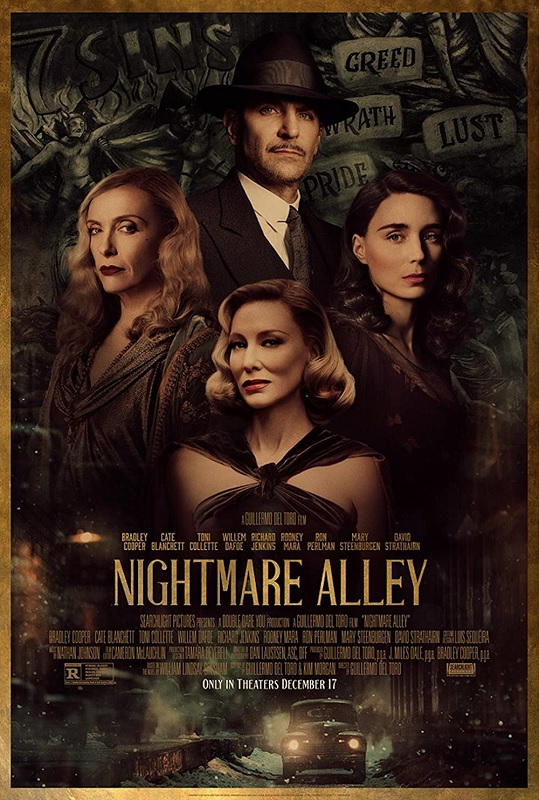

2021 – Nightmare Alley
I honestly didn’t know what to expect when I sat down to watch this movie. The trailer made it look like a psychological thriller set in a gothic and mysterious carnival freak-show, and there was that element to the narrative. But it was a lot more. There was no supernatural element to the story as I had expected, which actually worked very well. In fact, the story goes out of its way to show you how some of the mysteries work, the trickery used by the carnies to guide their audiences into fooling themselves. But that’s just the setting.
The movie is actually about how one man, through greed and hubris, caused his own downfall. Bradley cooper played Stan Carlisle, a drifter in 1939, who wanders into a carnival, where he takes a job from the owner of the carnival, Clem, played by Willem Dafoe. Cooper turns in yet another great performance, and I have yet to see Dafoe not act the hell out of whatever part he is playing. Other carnival performers are Toni Collette, playing Madame Zeena, and her husband Pete, played by David Strathairn. He falls for Molly, the electric girl, played by Rooney Mara, and meets her guardian, Bruno, the strong man, played by Ron Pearlman.
The second act of the movie moves to Buffalo and the wealthy elite, where Stan and Molly start their own show at a fancy nightclub. They are so convincing that they attract the attention of psychologist Lilith Ritter, played by Kate Blanchette, Judge Kimball and his wife, played by Peter MacNeill and Mary Steenburgen. Also the super-rich Ezra Grindle, played by Richard Jenkins. So there are quite a few big names in the ensemble cast, which is always pretty impressive. The actors all knew what they were doing and did a great job. No complaints there.
But I have to make special mention of Toni Collette. I have never seen her turn in a bad performance, and she really stood out to me here. She had this strange serenity about her that made her draw my focus. She was perfect as the tarot-reading Madame Zeena. The first movie I ever saw her in was Muriel’s Wedding, which came out in 1994. I also loved her in The Sixth Sense in 1999. But she also proved she could play a common woman in a great comedy in 2006, in Little Miss Sunshine. She was great in those films, and she was great in this one. She has come a long way, and she’s doing great. Good for her!
Something else I loved about the film was the aesthetics. In the first half of the movie, there was the dark and mysterious carnival, which has a gothic charm all its own. But the second half of the movie switched gears, and had a gorgeous Art Deco style that has always grabbed my attention in a good way. From the set designs, to the costumes, to the hair and makeup, I love the look of everything. And the haunting score by Nathan Johnson was a wonderful backdrop to the dark and sometimes horrifying narrative, something that is fairly indicative of director Guillermo del Toro’s style. He seems to have a knack for those dark themes with disturbing images, and I generally like what he directs.
As I consider about it, I think one of the themes in the film are the dangers of temptation, not only from greed, but also of alcohol. In the beginning, Stan makes a point of staying away from drink, like an alcoholic who has sworn off liquor. But through his criminal con-artist association with Lilith Ritter, he begins to drink again, which leads to his eventual catastrophic and horrific downfall. Even the supporting character of Pete is shown to have ruined a successful career as a side-show mentalist because of an addiction to alcohol. And he ignored Pete’s rule of never making people believe you could talk to the dead. Only bad things could come from that, and boy, did they ever.
But if I look at the film in a different way, it is also a bit of a study about the dangers of the seven deadly sins. At one point or another in the movie, Stan falls prey to each one of them, greed, lust, wrath, pride, sloth, envy, and gluttony, as long as you can substitute alcoholism for gluttony. And the choices he makes, only lead him further and further down into a spiral of self-destructiveness. He falls so far that in the end, in order to get that next drink, that next sip of alcohol, he puts himself on a path of self-pity and misery that can only end in his own horrifying death. The ending was just chilling. And it emphasizes the idea that Stan is a man who just doesn’t know when to quit. As a lead character he goes on that journey and has a powerful story arch. From low to high in both love and success, and back down to low, all because he didn’t know when to walk away from his con.
So really, this movie wasn’t at all like I expected, but I really liked the story. It was unique and well-written. But apparently, it wasn’t as original as I had thought. it took very little reading on my part to discover that this is actually a remake of a 1947 film of the same name, which, in itself, was based on a novel by William Lindsay Gresham. I was actually a little surprised by this because there were some pretty disturbing themes in the film, and I wouldn’t have thought that a film from the 1940s would have tackled the dark subject matter. Now, I’m curious to find that original film version, just to see what the differences are. And I can only imagine what kinds of things had to be left out from the original novel.








